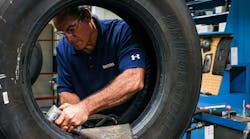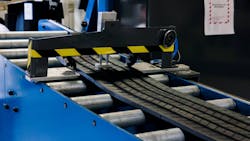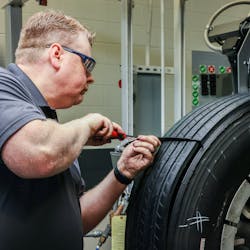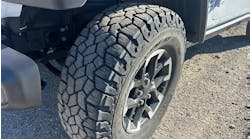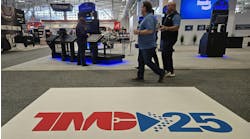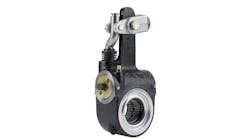Fleets must always find ways to efficiently operate assets while actualizing the best margins on expenses. Tires, of course, are atop the list of fleet expenses. Today, retreading is a viable and reliable option for fleets looking to cut costs while also delivering on a positive environmental impact. With advances in material sciences and technological developments in production processes, fleets can leverage retreads knowing that they will prove equal performance at a fraction of the price versus purchasing new.
Retreading & TCO
So, what can retreading offer a fleet?
“Retreading has two fundamental benefits for a fleet, with the first being the total cost of ownership (TCO) savings utilizing the full life-cycle value of the casing,” said Jaye Young, B2B marketing director, On Road, Michelin. “With technological advancements in retreading over the last few decades, a fleet can reliably retread on the drive position, spreading the initial cost of the casing over several lives and leading to significant cost savings.”
Lowering TCO is always a bonus, particularly when it cuts away from one of the most expensive aspects of operating a fleet.
“Tires are the third-largest expenditure for a fleet behind people and fuel,” explained Brian Cunningham, VP of fleet solutions at Bridgestone Americas. “Commercial truck fleets can improve their total cost of ownership by incorporating retreads into their tire program. With many retreads selling for 30 to 50% less than comparable new tires, while performing equal to or better than some quality new tires, retreads provide commercial truck fleets the ability to reduce costs without compromising on performance.”
And as costs are lowered, so too are the materials and waste from using retreads.
“The second benefit,” Young followed, “is for companies that are prioritizing sustainability, as retreading helps to reduce landfill waste and raw material usage.”
Shaun Uys, head of U.S. market replacement truck tire at Continental, concurred.
“Fleets should consider that retreads provide sustainability improvements,” he said. “Each retread tire saves almost 40 lb. of raw material, including rubber, steel, and carbon black, as well as 15 gallons of oil, according to the Retread Tire Information Bureau.”The economic benefits of retreading, along with the advancements in retreading and the additional sustainability improvements, make it an ideal component to be incorporated into any commercial vehicle fleet.
In late 2021, Penske Truck Leasing extended their contract with Bridgestone Americas to test, develop, and deploy Bridgestone advanced fleet technology and mobility solutions. As part of the agreement, Penske also remained a preferred customer of Bridgestone’s commercial tires and Bandag’s retread tires. In 2020, as a result of the relationship and through the use of Bandag retread tires, Penske—a fleet of more than 415,000 vehicles—was able to decrease tire waste by 11.5 million pounds.
“We continue to build upon the partnership,” said Chris Hough, VP of maintenance design and engineering at Penske Truck Leasing. “Just shy of 96% of all our drive tire and trailer tire replacements, [size] 19.5 and up, are retreads. It’s a very high percentage for one reason: it works. We wouldn’t continue to build upon the relationship and try and utilize as many recaps as we do if it wasn’t as reliable and dependable, not only for us, but for our customers.”
As part of this program, Penske is closing in on half a million retreads annually, explained Jason Roanhouse, executive director of Bandag Operations. “If you put that in economic and environmental terms, that is a huge, huge sustainability impact… Some of that savings always finds its way into the market at the end of the day. So, not only does it have the huge environmental benefit, but it’s got the economic downstream benefits that play out as part of it.”
“Also, if you’re getting the same performance at a lesser cost, it improves your bottom-line performance while you’re doing the right thing for the environment,” Hough stated. “It all rolls together.”Managing a retread program
There is a lot to consider for fleets looking to bring retreading into their operations. It starts from the top down, Uys related.
“Making retread a part of a fleet’s program begins at the top with the fleet owner and maintenance manager selecting tires that can be retreaded and aligning their organization with a retread network,” Uys said.
“With fleets utilizing equipment for longer periods of time and with more frequency, service partners are key. Whether that’s the manufacturer or dealer, this relationship can improve total cost of ownership,” said Aaron Murphy, SVP, Double Coin. “Choosing the best performing and retreadable tire for each application is pivotal; [the] lowest price is not always the answer to driving down maintenance costs.”Penske’s Hough suggested meeting with suppliers directly.
“I think feeling comfortable with your tire supplier is step one,” he said. “Go visit. Go do a plant tour of the retread plant. I’ve been in a lot of retread plants over the years. You walk into some, and you want to turn around and walk back out. Today, if you were to walk into the Bridgestone retread plant, it’s clean; it’s well lit; it’s organized. That impression is reality. If they’re clean, well lit, and organized, the chance of you getting a better product is much higher.”
First impressions on the plant and organization aren’t the only thing to bear in mind when touring, Hough continued. He suggested learning how that plant is performing their casing inspections and believes that shearography (a non-destructive inspection that looks for separations in the casing without having to disassemble the casing to do so) inspections are of much higher quality than just visual inspections.
Furthermore, this relationship building is an ongoing process—one not sustained through only an initial plant visit. And the continuous face time and communication will yield results, Hough continued.
“Our team visits on a monthly basis,” he said. “We look at every tire that they couldn’t recap, and we understand why. What happened? Was it something that our customer did? Was it something we did? Did we run it too low for some reason? We want to understand, and they are very good at helping us understand exactly.
“And, from time to time, we will tweak our parameters a little bit,” Hough said. “During those visits with our tire team, we work together very closely. And if Bridgestone has something new or something they think we can do better, maybe stretch a parameter or our specs, we do that. We’re going with their advice because they’re the tire experts.”
“And lean on those guys,” Roanhouse concurred, speaking on supplier relationships. “They are resources. They’re consultants. They’re there to educate on how to use less of the product, because it’s time over money. Those good commercial tire dealers that are out there with their expertise—lean into those folks. Their job is to maximize the return on your tire investment.”
Uys concurred on the importance of relationships, saying that fleets should leverage frequent communication with dealers, particularly in the forecasting process. “This is more important now than ever to ensure they receive the right products in this unprecedented environment,” he said.
And, when purchasing a new tire, fleets should consider it as two purchases, Bandag’s Roanhouse suggested. The casing, he said, is the asset to be managed—the raw material. The tread is the other piece of the purchase, and it is designed to be replaced and perform the functions it needs to—whether that be traction, wear or fuel efficiency, driver confidence, etc.
“Tires, like anything else, are return-on-investment items,” Roanhouse emphasized. “You don’t check your oil by hitting the engine with a hammer, and tires are much the same. You don’t check your air pressure by kicking it with your boot or using your highly calibrated sledgehammer to hit the tire. It just doesn’t work that way. You have to manage the program; you have to manage the tires; you have to invest, like Penske does, to get the return on investment of what you’ve purchased initially.”
Roanhouse added that the management of the tire program is multifaceted. A fleet must consider the corporate initiatives around tire maintenance, as well as working alongside the maintenance department to focus attention on tire monitoring and proper maintenance.Maintenance considerations for retreads
There are not many changes for the maintenance team regarding tire maintenance when it comes to servicing retreads, but the emphasis will be placed on prolonging the life of the casing.
“The integrity of the casing is key to retreading,” stressed Tommy Bazzell, director of national account, truck stop & trailer OEM sales, Yokohama Tire. “Proper psi, proper matching of duals, proper mounting techniques, proper casing repair practices, alignment of equipment, and operational tire awareness of drivers (i.e. safe driving techniques) can prevent impact breaks and reduce flat spots due to excessive braking.
“Proper brake adjustment practices can help prevent flat spotting. This condition can reduce or prematurely end the life of the casing,” Bazzell continued. “Maintaining proper psi through technical means or through pre-, in-, and post-trip inspections will ensure the integrity of the casing.”
In-shop activity and establishing strong maintenance practices for a fleet’s tire program will help get the best TCO out of the tires.
“When that truck is in for an A, B, or C preventive maintenance—really pay attention to what those tires are telling you, because spending a little bit of time looking for different, irregular wear patterns will really help you understand how to maximize what you get out of it,” Roanhouse said, continuing that tire rotations, matching of tread depths, and inflation monitoring are critical.
“Pressure. Pressure. Pressure,” he stressed. “Tires are expensive; air is free; keep some in ’em. You don’t have to be perfect about your tire program, but find an inflation pressure that that aligns with your typical loads and run that pressure and you’ll eliminate the vast majority of the issues that you face.”
Penske’s maintenance team will immediately pull a tire from service for repairs if it reads an inflation pressure at a 15% loss below the recommended level, Hough explained.
Timing is everything, and keeping a tire operational for retreading down the road is different than maintaining a tire until end-of-life.
“There are a few ways to ensure that commercial truck drivers and fleet managers can be proactive in their tire management to improve their total cost of ownership, and it starts with properly maintaining the tire casing,” Bridgestone’s Cunningham said. He continued with vital tips on properly maintaining a tire casing to ensure fleets get the most out of their investment, such as:
- Avoid exceeding the tire’s recommended maximum speed.
- Choose the right tire for the job by considering its load carrying capacity, tire size, speed capability, and service type.
- Regularly inspect tires for harm such as penetrations, damage to the sidewall, and inadequate tread depth.
- Regularly check and adjust tires to the appropriate cold inflation pressures before each trip.
“In order to provide commercial tires with the best chance for being retread, proper tire maintenance—including managing proper air pressures—is key,” Cunningham emphasized. Also increasing retreadability rates of tires are properly maintained wheel alignments on tractors and trailers, as well as tire rotations at suggested mileage intervals, he continued.
Tread depth monitoring will determine the retreadability of casings. Hough explained that Penske, generally speaking, will pull casings from service at the 5/32 mark for retread.
“We don’t let them run down to DOT level because we want to maintain that casing integrity,” he reaffirmed. “The lower the tread gets, the more susceptible it is to damage. Over the years, we’ve learned that we’re better off pulling it a little bit early versus what the DOT requires.”
“A $100 casing can get a lot more life if you avoid punctures and impacts and stone drilling and other things by spending $3 of tread pulling it a little bit early,” Roanhouse furthered, speaking on tread depths. “So, do you want to run three more dollars of tread per 32nd? Or do you want to save a $100 casing? And that’s the question that you have to ask yourself.”
Proper training for drivers and maintenance personnel, along with the use of technology where applicable, can help to better monitor and prolong the life of casings, as well as lower maintenance costs, explained Double Coin’s Murphy.
“Casings are assets. So, driver training on pre-trip checks is very important,” he said. “In addition, auto-inflation systems pay for themselves by offering warnings and solutions when a tire is failing. Anytime you can use technology to preserve a casing, you’re driving down maintenance costs.”
“The key is to get the most value out of the casing after the original tread life has been utilized, whether through retreading or selling the casings,” Bazzell concluded. “Having the opportunity to retread the casing multiple times will improve the total cost of ownership.”
